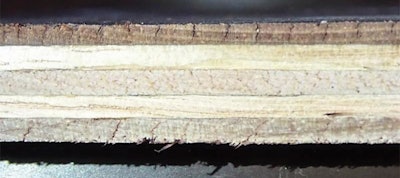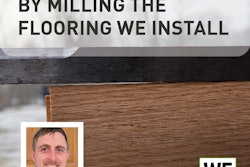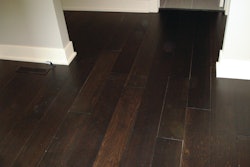
 This engineered floor's veneer appeared to be upside down.
This engineered floor's veneer appeared to be upside down.



The Homeowner's Issue
The homeowner selected a 4-inch sliced-face engineered floor to replace a solid strip floor. During the first year, the homeowner began noticing little lines running the length of the planks. Many of these lines were elevated. The homeowner called the retailer, who said the damage was caused from topical moisture, which isn't covered by the warranty. The homeowner eventually contacted an inspector.
Roy: The Inspector's Observations
At the time of inspection, the floor did have elevated grain edges approximately 1/8 inch apart. These lines were also darker in color than the rest of the floor. Looking at leftover material, I found the lines were present but not as pronounced as they were on the installed floor, which the homeowner maintained using the recommended cleaning process. I cross-cut the specimen into ½-inch-wide pieces to review under a microscope and saw the lines were knife checks from the slicing process of the wear layer. Because the stain had penetrated down into the knife checks, it was apparent the checks had been present at the time of fabrication. After the floor was installed, moisture got inside the knife checks (likely from cleaning) and elevated the checks enough to be seen under normal lighting. With a sliced or rotary-peeled material, the veneer should be glued with the loose side (knife checks) down to the core. The conclusion was that the issue was a manufacturing defect.
Blake: The Attorney's Analysis
Clearly this is a product defect and not an installation or owner maintenance issue. We can confidently assume the manufacturer's warranty does not cover labor to replace the flooring. As such, the other parties will need to pay the extra labor costs, and their responsibilities will depend on the language in their respective agreements. Often a retailer's credit applications, invoices, or other packing documents disclaim liability for product defects (and if they do not, they should). Most applicable laws make claims for defective products a "pass through" to the manufacturer and absolve the retailer from liability. Therefore, the labor costs to replace the flooring will likely fall on the owner and the installer. If the installer has a solid written agreement, it will disclaim any product defects and related costs. This would leave the owner holding the bag for the extra labor costs. However, even if the other parties can legally dodge liability, they will all have a very unhappy customer if they do not contribute. The installer and retailer will likely need to make a business decision to chip in and keep the peace, with the real culprit simply obligated to ship out a few boxes of new, non-defective material.
RELATED: Engineered 101: Understand the Fundamentals of Engineered Wood Flooring

































